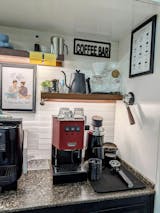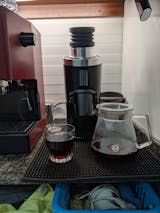
5 Things that can go Wrong while Making Coffee
Share
Every day, more than 1 billion individuals consume coffee, with some having more experience than others. Even the most experienced coffee connoisseurs make mistakes that are not only embarrassing but can have an impact on the taste of their coffee. While brewing the perfect cup of coffee is an art, you can be compromising its flavor and quality by making a few common mistakes.

If you are unsure of what could go wrong while brewing your perfect cup of coffee, do not worry; we are here to assist you in being the finest home barista possible.
The common coffee mistakes you probably make at home are listed below:
1. Using an incorrect coffee-to-water ratio
Many individuals simply need to consider the coffee-to-water ratio when brewing a cup of coffee (or a pot) which is one of the most common coffee mistakes.
There is no ideal coffee-to-water ratio because it is ultimately a personal preference. However, the majority of experts concur that a 1:16 ratio is typically thought of as a reasonable starting point when pour-over brewing. Basically, it means that you should use 16 grams of water for every one gram of coffee. You may always experiment with different ratios until you find the ideal brew for your taste buds. You can also change this ratio to fit your particular preferences.

Tip- If you're new to the world of coffee, avoid just adding more coffee to get a stronger brew. You might have a bad experience with it.
2. Buying coffee of poor quality
Coffee is one of those commodities where you get what you pay for. If the flavor of your coffee isn't very good, you're probably buying cheap coffee beans on a budget. It is one of the most common coffee mistakes. The best coffee beans should be organic and fair trade certified. Your wallet and your buds will both appreciate it. A perfect cup must have the right balance of acidity, bitterness, and sweetness.

Tip- Test the mixture if you aren't an expert yet by pouring a teaspoon of the ground beans on top of a glass of ice water. If you buy high-quality coffee, the color should not seep into the water in a matter of minutes.
3. Using the incorrect type of coffee mug
It's easy to underestimate the importance of selecting the ideal cup for your coffee-drinking experience, but this isn't the case. Choosing the ideal mug for that delectable brew is essential to the entire coffee experience. A plastic mug is not an option if you like your coffee as hot as possible. Skip buying mugs that are thin and flimsy. Your hot cup will quickly cool to room temperature due to the speedy heat loss.

Tip- Choose a handcrafted, thick-walled ceramic or glass mug. Invest in a high-quality travel mug if you're constantly on the road so you can take your hot coffee and keep it that way.
4. Using subpar water for your coffee
Don't compromise on the water if you're using the best beans or roast. A cup of coffee contains over 99% water, so don't skimp on the water while brewing your favorite cup of joe. However, it might not be the first thing that comes to mind.
The minerals (and other pollutants) in tap water, whether it is hard or soft, can taint freshly brewed coffee. Water quality is affected by a variety of factors, including where you live, so drinking straight from the tap may be harmful to your cup.

Tip- Use filtered water instead of Tap water. Better water makes for a better cup and is also kind to your equipment.
5. Adding excessive amounts of sugar to coffee
If you purchased premium coffee and stored and prepared it properly, there is no need to add a heavy amount of sugar to your coffee. Most people add sugar to their coffee because it tastes bad.

Tip- If you get high-quality beans and make your coffee correctly, you'll enjoy the flavor of freshly ground coffee.
On a final note,
Whether you've been making coffee for a month or ten years, there are mistakes you're making that are impacting the flavor of your brew. We have discussed some of the most typical errors and strategies that you can use to ensure that you have brewed the ideal cup of coffee at home.









